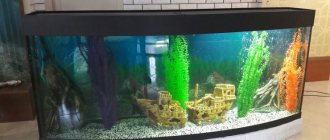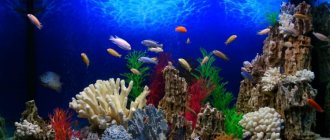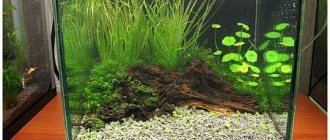Ordinary silicate glass is a traditional material for making aquariums, environmentally friendly and reliable. However, it has a worthy competitor - organic glass, a polymer known as plexiglass. It is quite possible to make a plexiglass aquarium with your own hands by choosing an original design. A vessel made of polymer material has undoubted advantages over a glass aquarium, but also has a number of disadvantages.
Description of a plexiglass aquarium
These products are available in both traditional rectangular (or square) shapes and curly ones .
This is possible, since organic glass has one feature - it is easily formed. From plexiglass you can, for example, make a spectacular panoramic aquarium with a slightly convex front surface. As well as multifaceted or wave-shaped designs, cylinder aquariums also look very impressive.
Due to the high plasticity of the source material, there are often no seams in the finished product (or their number is reduced to a minimum).
If you need to connect individual parts of a plexiglass aquarium, the diffusion method is used. Otherwise, the polymers are firmly bonded to each other at the molecular level. These seams are particularly durable.
Features of the construction of frameless material
A frameless fish house is made from thin material using chloroform and dissolving plexiglass shavings. It is recommended to carry out work in a well-ventilated area or outdoors. The gluing areas must be treated with sandpaper, then treated with acetone and lubricated with glue. Then install the walls on the bottom of the structure by installing spacers. Then secure it with a tourniquet.
At this point, you have almost completed assembling the aquarium with your own hands. Now all that remains is to choose a location for installation. It is better to place a fish house near the side wall of the house at a distance of 1–2 m from the window - this way the fish will get more light. The background for the aquarium will be wallpaper or other wall covering. However, you can choose the background for the back wall and install it yourself. Remember that during work you need to think about your own safety and work carefully, especially with sharp tools.
Characteristics
Let's look at the main qualities that are important for an aquarium. Its glass should transmit light well without distorting the surface - this is indicated by light transmittance. A certain resistance to loads and impacts is also required - let's talk about strength. And the walls of the product should easily hold the entire volume of poured water. More on this later.
Thickness
The more spacious the future aquarium is planned, the thicker sheets of acrylic glass must be used. But this is not done by eye, but by calculation. On the Internet you can find special calculators where you need the size of the water column. At the output we obtain the required thickness of the material. Or you can contact specialists who will make accurate calculations. We take into account that the maximum water pressure (safe) is no more than 3 MPa.
Here are the most commonly used standards:
- For a product with a capacity of no more than 30 or 40 liters, you need a sheet of plexiglass no thinner than 3 millimeters.
- More substantial aquariums (up to 80 or 100 liters) require a thickness of at least 4 millimeters.
- Sheets 6 mm thick are used for volumes up to 200 liters.
- If the capacity of the future aquarium is more than 200 liters, then you will need acrylic glass from 8 to 16 millimeters thick.
Light transmittance
This parameter for plexiglass is 92 percent. This is the same level as silicate glass. But it is worth noting that the latter has a slightly greenish tint, almost invisible in the air. But when you look through glass walls at the inhabitants of the underwater world, the color spectrum is slightly distorted (a little green is added).
Transparent plexiglass has a refractive index almost equal to water . This allows you to see the world inside the aquarium absolutely without distortion, in all its natural colors. After all, a ray of light is refracted only twice.
Strength
We all know how fragile silicate glass aquariums are. When hit hard, they are unable to resist - the fragments along with the water scatter in all directions, and most of the fish die. However, this is also fraught with injury for humans. Organic glass is much more resistant; it is not broken even by a billiard ball (there have been such cases). As a rule, the impact leaves only scratches that can be removed later.
Naturally, acrylic glass also has a tensile strength. However, the result is not so critical. The cracks on the walls do not go any further: you can manage to save the inhabitants of the aquarium from death, scoop out the water, and avoid getting injured. This way you will be able to avoid the wrath of your neighbors below, and the fish will remain alive and healthy.
Installation in place
Gluing or assembling plexiglass for an aquarium is only the main part of the matter, but not the whole. It is also important to place the aquarium in the right place. It is best to do this at the side wall, at a distance of about 1-2 meters from the window or opposite it. If you install the structure against the wall, then its background will be wallpaper or what is behind the aquarium. This is worth remembering when choosing the location of the structure. True, the wall can be covered with material of the appropriate color. The aquarium is installed on rubber or foam rubber on a flat horizontal surface.
Reviews
These products have both fans and opponents. Let's start with the first ones.
So, supporters of plexiglass aquariums like:
- high transparency of the material and natural colors of swimming fish;
- wall strength and “eternal” seams;
- safety of the product;
- variety of aquarium designs;
- light weight.
People who have a negative attitude towards such aquariums point to the following disadvantages:
- the ability of plexiglass to scratch easily;
- its sensitivity to heat;
- slight protrusion of the walls of the aquarium due to the plasticity of the material.
All of the above shortcomings are completely correctable. Scratches can be easily removed by polishing. And if you clean carefully (with soft materials), then they will not be there at all. Correct calculation of wall thickness and competent design (ties, “box” ribs) make it possible to minimize swelling. But it only appears with large volumes (from 200 liters). As for heating, usually no one puts a house with fish near a hot stove.
Frame aquarium
Frame assembly
This design is considered the most common. The metal frame is the main element. The material is welded or soldered. Sometimes durable plastic is used instead of a metal frame.
The main rule is the correct shape of the structure and equal sides. The structure is mainly made in the shape of a parallelepiped.
After assembling the structure, you need to get rid of roughness and all kinds of defects, degrease the product inside and out.
Glass cutting
Organic glass is cut with a circular saw equipped with a thin cutter. If such a tool is not available, you can cut the sheet in another way: with a special cutter on a flat surface.
The sheet is marked, and the cutter must be drawn along the marks. At the same time, press down on the tool. This method takes a lot of time.
Important! To prevent the glass from being scratched or frayed, you do not need to remove the wrapping paper from it (plexiglass is sold wrapped). All markings are done on paper. You also need to cut the glass in the wrapper.
Plexiglas cannot be broken, as cracks will form. The edges of the cut product need to be leveled and sanded.
When the sheets are ready, they must be degreased along the edges using white alcohol or turpentine.
General assembly of the aquarium
The bottom is first glued to the frame, then the side walls. For gluing you will need a special silicone-based adhesive-sealant. The sheets are pressed tightly against the frame ribs. This is done to ensure that the air is completely removed. The joints of the walls also need to be lubricated with silicone.
When the gluing process is completed, you need to wait 2 - 2.5 hours and remove excess sealant. All work must be done carefully and carefully, otherwise scratches may remain on the glass.
After 5 days, the finished aquarium is checked for leaks. If there is a leak, the structure needs to be dried and the leak area coated with sealant, and checked again. If the aquarium does not leak, you can paint it with oil paint.
Photo
It’s better to see once than to read many times - let’s paraphrase a slightly well-known expression by presenting in this section a photo gallery of plexiglass aquariums.
The photo shows a plexiglass aquarium
They come in various sizes, shapes and designs. Perhaps this will allow someone to quickly decide on their preferences.
What to consider?
- Plexiglas is not fragile. There is no need to worry that if you accidentally hit your aquarium with something hard or sharp, you will cause a “flood”. For this reason, this material is much easier to transport, process and store;
- It can be sanded, cut, glued and bent. Due to its pliability, plexiglass can be processed with virtually any available tool, resulting in exactly the result that you need. Due to its low melting point (160°C), this material can be given almost any shape. But be careful: the boiling point is only 200°C, so if plexiglass is overheated, you will get a viscous, shapeless mass, and not a flexible and pliable material. That is why beginners are advised not to try their luck, but to buy a ready-made aquarium made by specialists;
- Scratches and roughness easily appear on its surface. This is a kind of “payment” for flexibility and pliability. If handled (and used) carelessly, scratches may appear on the surface of the material, which will significantly deteriorate the aesthetic qualities of the aquarium. But this problem can be eliminated by using a special grinding machine with the appropriate paste. True, without good experience, it is difficult to achieve complete translucency; there will still be roughness on the surface that will be barely noticeable.
Correct cover
The answer lies on the surface - naturally, for such a product it is better to make the lid from the same material. After all, it has many advantages:
- The pliable material makes it easy to make technological holes (for attaching lamps, a cooler for blowing, feeding fish, and others).
- The lid fits perfectly with the aquarium, forming a single whole with it.
- It is strong, does not grow mold (unlike plywood, for example), is lightweight and lasts a long time.
- Special paint adheres well to organic glass and a film is glued on.
The main condition is that the thickness of the plexiglass sheet for the lid must be sufficient so that it does not sag (from 4 millimeters or more, depending on the size of the aquarium). The inside is often covered with a silver film, and the outside is made dark.
Cutting plexiglass
Now that you have selected the necessary material, you will need to cut it. To do this, use a cutter. Apply markings on the acrylic sheet in advance, place a metal ruler at the cut site and move the cutter along it with a firm and confident movement. Plexigas is very easy to scratch, to avoid this, it is better to cut it in the wrapping paper in which it is sold. Apply the markings directly on the wrapping material.
If you have chosen acrylic with a large thickness, then it would be better for you not to use a cutter, but, for example, a circular saw. Choose the thinnest fabric you have.
When all the parts have already been cut out, they will need to be further processed; use a wooden jointer with a sharpened blade for this. You should not be overzealous; you only need to remove the steps that were formed after more than one pass of the cutter.
Polishing
Now let's talk about the unfortunate scratches that some people are so afraid of. If they are very noticeable, then first you need to go over them with fine sandpaper. If you have a manicure machine at hand, then put a felt attachment on it and finish what you started.
As a polish for a plexiglass aquarium, use GOI paste (the best option), and in its absence, tooth powder. The powder that is sold for cleaning false teeth is also suitable.
Craftsmen have come up with another method of polishing, which requires the application of certain forces. The tool is made from a piece of felt (from a felt boot) and a lint-free paint brush. Having connected one to the other, apply polishing paste to the felt and rub the scratched areas vigorously. It turns out long, but effective.
Important : the water will have to be drained before polishing.
Calculation of future design parameters
Before you start assembling an aquarium, you need to calculate its rational dimensions. Plexiglas for an aquarium must be of high quality. In order to select the optimal thickness and height, you can use a special calculator, which you can find on the Internet. This is necessary to ensure that your aquarium is reliable and durable. Acrylic is characterized by increased plasticity in comparison with quartz glass, therefore, under water pressure, if the parameters are incorrectly selected, it can bend. It is worth following the rule: the longer the aquarium, the thicker its walls should be. If you have the opportunity to purchase special aviation plexiglass, this will be an ideal option for making an aquarium.
Advantage
- This product can be given any fancy shape. Note that in this case the aquarium will remain reliable, strong and very stable.
- The transparency of the walls and the minimum refraction of light rays allow you to admire the underwater world in all its beauty, without distortion.
- The strength and lightness of the material makes aquariums easy to transport and move around the apartment. These qualities are also very useful for the top cover.
- Acrylic glass, compared to regular glass, holds the water temperature much better. This property can be useful in the cold season.
- Plexiglas aquariums are practically unbreakable . They are also absolutely airtight - after all, their seams (if any) are made at the molecular level. Therefore, there will definitely not be any leakage.
- You can easily and quickly make a hole of any shape in the walls and lid of these products (either technological or for water drainage).
Manufacturing frameless
The frame design is undoubtedly reliable and durable. However, aquarists often use the frameless method. Thin glass is not suitable; sheets 8-10 mm thick are required. You also need glue in the form of a mixture of acrylic and chloroform. Plexiglas plates are cut in the same way as for the frame structure. They are glued together like this:
- The bottom is placed on a rubber mat, and the windshield is placed against it.
- A thin wire is placed at the joint, and glue is poured there.
- The wire is removed.
- Using the same technology, the side sheets and the back wall are glued.
- Stiffening ribs and spacers are used to prevent the structure from bending.
The finished aquarium is dried for 3 days, then checked for leaks (filled with water).
On a note! Along with chloroform, dichloroethane or acrylic oxide can be used. When performing work, the room must be ventilated, as these substances are toxic.
Gluing
Acrylic aquariums are glued together using a special technology using solvents - dichloroethane, trichlorethylene or special adhesives. This production is very toxic and requires additional investments in the workplace organization system and further storage for the purpose of weathering solvents. Correctly glued seams are absolutely transparent, creating the impression of solidity of the entire structure. But it takes 10 to 30 days for the solvent to erode. In other words, achieving high quality of the finished product is accompanied by additional time expenditure.
Stages of work
In order to make an aquarium, you need to follow this algorithm:
- the glass is pre-prepared: the edges are processed, the presence of defects on the glass is examined;
- the glass is processed, cleaned, and then thoroughly dried;
- a canvas is laid on the surface, which will play the role of the bottom;
- An adhesive composition is applied along the edges, onto which the side walls are installed one by one;
Reference! The sealant is squeezed out evenly, without the formation of voids or excess.
- after this, the structure is left until the adhesive composition has completely dried;
- then the aquarium is turned over on its side and stiffening ribs are installed, after which a couple of days are also waited;
- Upon completion of the work process, excess sealant is cut off.
What kind of glue is needed
There are many choices of glass glue, but most formulations contain components harmful to underwater inhabitants. You should not listen to seasoned professionals who claim that they glued the aquarium with simple construction glue and “everyone is alive and well.” They were just lucky.
We invite you to familiarize yourself with Background for an aquarium (34 photos): 3D volumetric background, black decorations for an aquarium with fish, the best aquarium interior backgrounds
A good aquarium glue must meet the following requirements:
- do not contain dangerous compounds;
- ensure high strength of connections;
- the structure of the glue must be elastic;
- color can be transparent or black;
- without impurities, including antibacterial ones.
Products that are approaching the expiration date should not be purchased. You can no longer expect strong seams from him. The best option in this situation is silicone sealant. It will reliably glue glass and withstand mechanical loads of up to 200 kg per square centimeter of area. This is relevant when gluing large tanks.
Is it that simple?
In theory yes, but in practice everything is different. Assembling an aquarium for a beginner who has never worked with plexiglass is a very difficult task, especially considering the “capriciousness” of the material. Therefore, it is recommended to first “practice” by assembling a 20-30 liter jar, and then move on to more complex tasks. And ideally, just buy an aquarium with equipment in an online store, see how it works, check all its advantages, features and disadvantages in practice, gain experience, and only then assemble your own.
Yes, it will cost more, but you will be able to gain valuable knowledge and experience, rather than correcting defects during operation. Even a rare transplant of the inhabitants of an aquarium for its “maintenance” is a difficult and very “stressful” task for fish, shrimp and snails, so it should be resorted to only in extreme cases.
Value your time, nerves and money. Contact the WuShop online store, created specifically for beginners and professional aquarists. There is everything here, from fish food, chemicals to panoramic aquariums with powerful equipment.
Choosing the shape and size of the aquarium
First you need to choose a shape and size.
For a long time, home ponds assumed the presence of a metal frame into which glass plates were attached. The walls of such a tank turned out to be extremely straight. Frame structures have two big drawbacks: they are very heavy, and after draining the water, the seams dry out, you need to cover them again. Gradually they were forced out of the market by frameless options. Aquarists are divided into two groups: some like rounded, unusual shapes, others prefer classic rectangular ones. Each category has its pros and cons.
All designs of glass dwellings for aquatic inhabitants can be divided into the following groups:
- rectangular;
- round;
- panoramic;
- corner.
Any of these models can be made independently, except for the round one. Here you will need a glassblowing profession and special equipment. The corner one looks interesting, but it involves increased complexity in creating frame elements. When making it, you will need experience working with glass. If you don’t have the skills yet, it’s easier to start at home with a regular rectangular-shaped tank.
The dimensions and proportions of the tank depend on the location, number and type of aquatic inhabitants. It is believed that in a large aquarium it is easier to establish a biobalance, which means it is easier to care for. A 100 liter tank is the best option. It will not take up much space and will allow you to show your imagination. You can plant beautiful plants, add a three-dimensional rear view, and add a sufficient number of fish to the aquarium.
Standard aquarium proportions, which are convenient for care, placement of plants and decorations, assume a width equal to the height, and a length twice as long as the width. Fish feel comfortable in such conditions. But these proportions are not an axiom; they can be shifted in one direction or another.
Which glass to choose for an aquarium, silicate or acrylic?
Every day I am asked about the cost of an aquarium that they want to order. Every day I ask the Customer what kind of glass he needs the aquarium from. And every day I answer the question, what is the difference between these aquarium materials. And so I decided to write an article so that I can rightfully refer to it next time. So, in order.
Silicate glass is a hard, transparent material known since 2000 BC. The glassware found during excavations in Egypt and India dates back to this period. Surprisingly, the glass from which the double-glazed windows in your windows are made differs little from the most ancient samples. The chemical composition of window silicate glass is expressed by the formula: Na^O ·• CaO ·• 6SiO2; and the components are formed from the following products: Na20 - from soda, CaO - from limestone, Si02 - from sand. Depending on the purpose, silicate glass includes various additives and components. Aquariums are usually made of monolithic sheet glass of grades M1, M2, M3, ... M7 GOST 111-90 (ST SEV 5447-85) with a thickness from 4 mm to 25 mm.
In the manufacture of especially large aquariums, laminated glass (triplex) is sometimes used, but due to the use of connecting films, its optical qualities (transparency) are noticeably inferior to the main raw material - the M1 brand. Silicate glass is cut using a carbide or diamond glass cutter and processed using abrasive and polishing wheels. Heat treatment of a silicate glass sheet allows it to be bent into an arc workpiece (molding). The connection of the processed parts into a single whole (aquarium) is done using silicone sealant. Sometimes, when the manufacturing condition is the transparency of the seams, a special UF - hardening glue is used. The method of manufacturing aquariums using a metal frame is currently not used as it is outdated.
Acrylic glass (sometimes the term organic is also used) is a modern material. It is based on a polymer called polymethyl methacrylate (PMMA). According to production technology, acrylic glass is divided into casting and extrusion. Aquariums, as a rule, are made of cast glass with a thickness of 4 mm to 25 mm, but our company has produced aquariums from 80 mm and 120 mm acrylic. In this case, acrylic glass is made to order. To process acrylic glass, both mechanical and laser cutting are used with equal success; grinding and polishing are carried out using special abrasive pastes. Acrylic glass can be heat treated and can be molded into a curved part at a temperature of 140 degrees. Unlike silicate glass, acrylic glass can be heated and bent in a small area, which gives it a significant advantage in terms of processing. Acrylic glass blanks are glued to each other using one of the special polymer adhesives, of which there are currently quite a lot on the domestic market.
For each case, glue is used individually and there is no general rule of “worse” or “better”. Dichloroethane and chloroform are often used as glue, but since these chemical compounds are for the most part only highly effective solvents, working with these reagents requires special skill and dexterity, and, among other things, also compliance with the rules for working with health substances.
Which glass is the best for aquariums? Let's compare the materials discussed according to indicators that may be of interest to us, aquarists.
1. Transparency, optical properties. In our work, our company uses only the best grades of materials, therefore, according to this criterion (the ability to transmit light), both types of glass are equally good. It should only be noted that if acrylic glass is truly colorless, then silicate glass has a pronounced greenish tint, which is subsequently transmitted to the entire interior design of the aquarium. Because of this, many are inclined to believe that the water in natural reservoirs is actually greenish... I also had to listen, based on observations twenty years ago, to the opinion that acrylic glass turns yellow and becomes cloudy over time. Over the ten years that we have been making acrylic aquariums, no such cases have been recorded, with the exception of clouding from improper use (more on this later). To be fair, it should be noted that technical acrylic aquariums, from yellowish to specifically yellow, came across repairs. But I am inclined to associate this with the very composition of domestic plexiglass, manufactured in the 70s of the last century.
2. Manufacturability. Acrylic glass clearly wins due to its significantly lower (3 to 5 times) mass compared to silicate glass. Due to their weight, many silicate aquariums can only be manufactured directly at the installation site, which is not always convenient. But there are often cases when the total mass of a silicate aquarium exceeds, for example, the permissible load on the floors of a building, or causes serious deformation of the floor covering and communications located underneath it. But for an acrylic aquarium there are practically no restrictions. But before installation, you must definitely consult with specialists.
3. Tightness. Based on these indicators, one should rather compare the methods of joining acrylic and silicate glass. If silicate glass is connected to each other by a foreign material (sealant) according to the principle of adhesion (sticking one to another), then gluing polymer to polymer occurs due to diffusion (partial penetration of molecules of one substance into the crystal lattice of another). I will add that when working with silicate aquariums, it is necessary to pay additional attention to the quality of the sealant itself, since its remarkable properties depend on storage conditions, transportation, shelf life, etc.
4. Durability, maintainability. Since in addition to manufacturing, our company also repairs all kinds of aquariums, I can responsibly declare: silicate aquariums are repaired in relation to acrylic ones in a ratio of 10: 1. Broken walls, leaks, cracks and chips - all this indicates the advantage of acrylic glass over silicate in terms of strength. Each of us has seen at least once in our lives how silicate glass is cut: the master makes a cut of a few tenths of a millimeter, and then simply breaks the glass. The same thing happens with a silicate aquarium, the walls of which are subject to constant water pressure from the inside. Everyone has probably seen how silicate glass breaks. Easy and relaxed, with a ringing sound... After one of the walls of a silicate aquarium is broken, it often has to be completely disassembled, while in an acrylic aquarium it is enough to simply saw off only the damaged part at the seams. But it is almost impossible to break an acrylic aquarium without the help of a tool.
5. Practicality in operation. Cleaning an aquarium is an equally necessary process for both acrylic and silicate vessels. The same actions, the same back-and-forth movements for mechanical cleaning of inspection walls by applying special equipment to them. But the inventory is different for each material. If for a silicate aquarium you usually use a simple foam rubber dish sponge, and even with a hard, rough half, then for an acrylic aquarium this is simply unacceptable. How unacceptable it is to wipe, say, polished furniture, a TV screen, books or paintings with the same sponge. But the replicated “aquarium care manuals” and various “aquarist’s reference books”, as a rule, do not find this difference. I remember in the 80s, pet stores sold a product made of plastic and metal with a razor blade inserted inside and an extremely poorly placed screw with a nut, which was called an “Aquarium Cleaning Scraper.” Thanks to this device, the opinion has firmly taken root among aquarium lovers that “acrylic aquariums are easily scratched.”
There was nothing to object to... But the Russian aquarist is also a jack of all trades; polishing a scratched aquarium is a piece of cake for him. Using sandpaper - scratch paper, tooth powder, quartz sand and gasoline, the craftsmen of the last century actually removed scratches. But as a result, another “universal myth” was born: acrylic glass becomes cloudy over time... All these chimeras are alive to this day. To test the infallibility of a scratch-resistant silicate aquarium, a 300-liter rectangular aquarium was manufactured in our workshop in March 2005 for the author of this essay. I served him personally, having considerable experience as a designer. Indeed, despite the fact that the aquarium was installed “in the light”, equipped with a powerful lighting system for living plants (which required constant cleaning of the glass) and was redecorated several times, there were no scratches. But only until the moment when, in my absence, my mother, a thorough and energetic person, took up cleaning the aquarium. She saw many times how I clean the aquarium and with what I use, but nevertheless, scratches appeared in sufficient quantities to confirm that silicate containers are scratched. But unlike acrylic ones, they cannot be polished, even using all the available potential of our company!
6. Cost. Silicate aquariums are cheaper to manufacture than acrylic ones. This is due to the initial cost of the material, the more complex technology for manufacturing acrylic aquariums and a number of other reasons. But the cost of manufacturing aquariums with a volume of 500 liters or more is almost the same. And if we consider the production of an aquarium of this volume in a turnkey configuration (although what kind of key can be in an aquarium, and who, the fish?), then again the acrylic aquarium wins. Less metal for the stand, less costs for loading and unloading, delivery and installation, and an insured event. Also, the reason for the price leveling is the fact that silicate monolithic glass M1 with a thickness of more than 10 mm is practically not produced in Russia, and imported materials have to be used.
Conclusion: If you need a small home or office aquarium of a simple shape, you are limited by budget and are not inclined to overpay for essentially the same aquarium, then it is wiser to purchase a silicate aquarium from a well-known manufacturer or order an aquarium from a company that has its own production (with the exception of small glass workshops going bankrupt due to the growing popularity of plastic windows).
Our company recommends ordering an acrylic aquarium if: the aquarium is quite large (more than 500 liters); installed in a place that excludes the possibility of its dismantling (in a niche, as part of built-in furniture or a column); aquarium height more than 800 mm; the aquarium is intended for young children; the aquarium is installed in a bar, restaurant, store, exhibition, etc.; the aquarium is installed on the upper floors; a complex marine aquarium to which life support systems are connected.
Technological progress is inexorable. The best new displaces everything that is familiar but outdated. Acrylic glass is replacing silicate glass all over the world. Eye glasses and optical instruments, automotive and medical equipment, food industry and household appliances, sports industry and much more. The aquarium industry is also changing...











